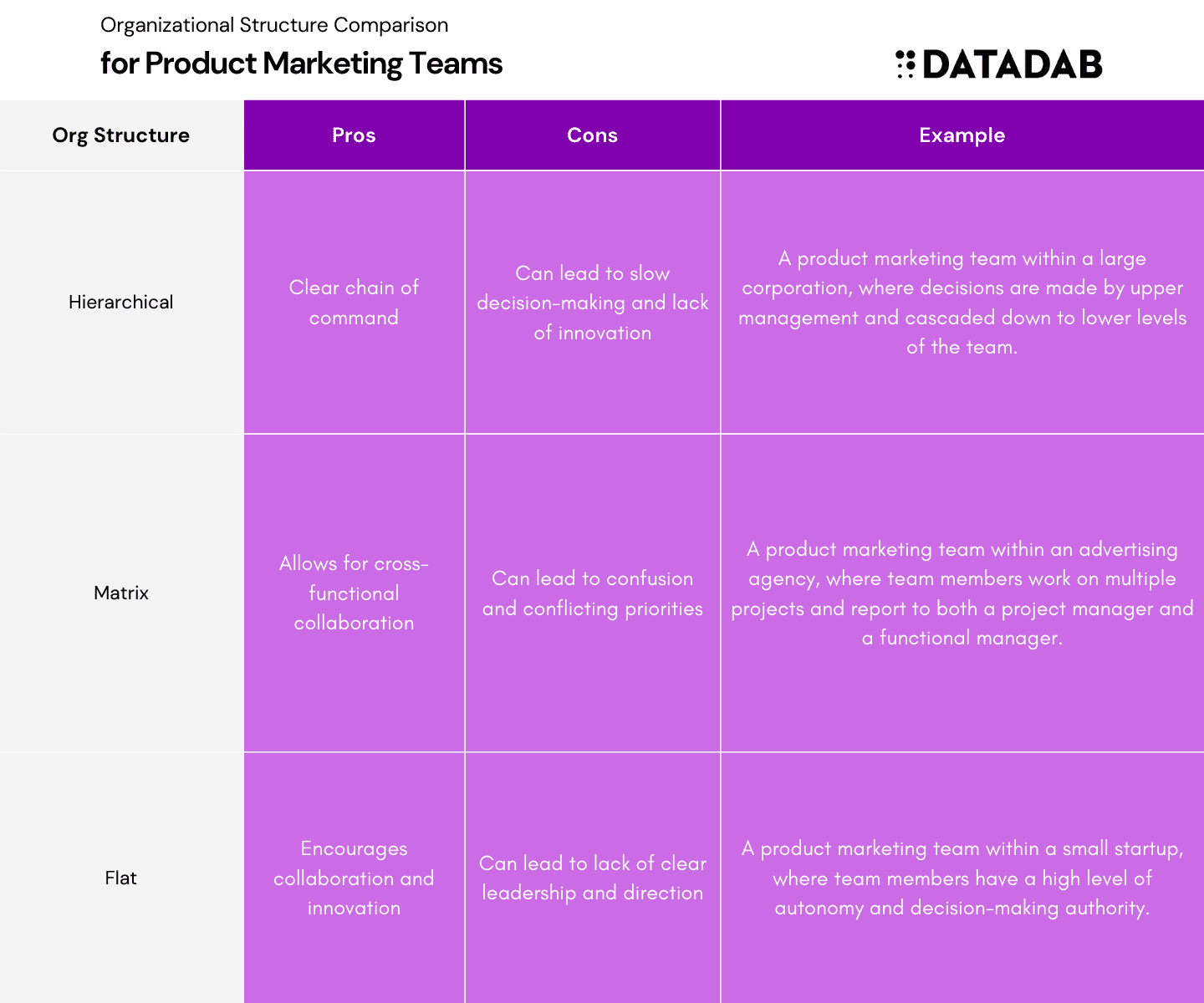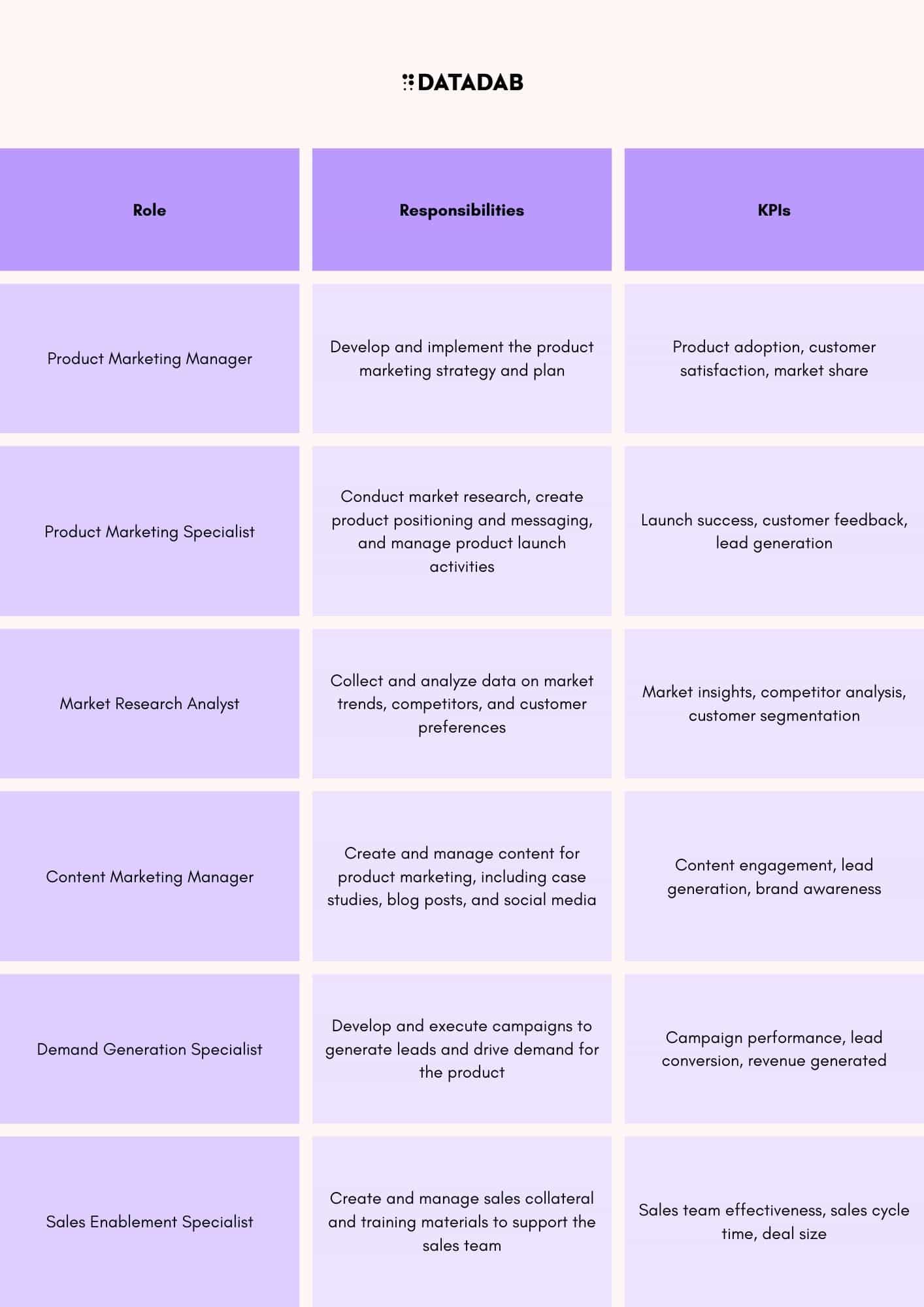While functional org structures can provide deep expertise and specialization within a specific area, they may also lead to silos and lack of collaboration across the team. As such, it's important to balance specialization with cross-functional collaboration and communication.

When building a high-functioning product marketing team, the org structure you adopt is the foundation for future success. Start by setting out the key roles that need to be filled as you scale your team. Product marketing teams can be large or small. There are many different ways of organizing them—but no matter what shape yours takes, a good org structure will support your company’s goals by scaling efficiently and in lockstep with how the company itself matures. A bad one will trip up your team and make their job harder.


Product Marketing Team Org Chart Template
[Company Name]
Chief Marketing Officer
- Oversees all marketing functions
- Establishes marketing strategies and budgets
- Hires and manages marketing team directors
Director of Product Marketing
- Leads the product marketing team
- Defines the product marketing strategy and vision
- Conducts market and competitive research
- Establishes positioning for key products
- Owns the go-to-market plans for product launches
- Manages Senior Product Marketing Managers
Senior Product Marketing Manager(s)
- Owns go-to-market strategy and product positioning for 1-2 major products or product lines
- Develops messaging frameworks, sales tools, and launch plans
- Manages junior product marketers for assigned products
- Works closely with product management on roadmaps
- Conducts buyer interviews and develops buyer personas
- Presenting products externally to analysts/media
- Execute go-to-market plans for specific products under senior PMMs
- Create sales presentations, FAQs, competitive matrices, etc.
- Work with content team on collateral like datasheets
- Analyze product usage data and customer feedback
- Manage product demo environment and sales training
Content Marketing Manager
- Develops content strategy aligned to buyer journeys
- Creates editorial calendar and assigns content projects
- Writes blogs, ebooks, case studies, and other collateral
- Promotes content through social media, email, SEO
- Analyzes performance of content and optimizes based on insights
Email Marketing Manager
- Manages email marketing campaigns and nurture streams
- Works with sales ops on lead flow and handoffs
- Tests and optimizes emails to improve conversions
- Analyzes email data and campaign performance
- Ensures compliance with email regulations
Events Manager
- Plans product launches, tradeshows, and customer events
- Manages logistics like venue, A/V, catering
- Promotes events through email, social media, etc.
- Oversees booth design and printed collateral for events
- Tracks event performance and provides recap reports
Your team structure is the foundation of your product marketing organization.
To start, you need to set out the key roles that will make up your team. Product marketing teams can be large or small depending on several factors, but some core roles will likely appear in every kind of org structure.
The right org structure acts as the foundation for your product marketing organization. It ensures all the right elements are in place and everyone works together toward company goals. A wrong org structure gets in the way, creating confusion around responsibilities and slowing down execution.

Most organizations can be described as either flat or hierarchical. Flatter structures will have fewer levels between top leadership and front-line employees, while hierarchical structures have multiple layers of management between leaders and those doing the work.

Define what good looks like for your product marketing team.
To determine what a “good” product marketing team looks like for your organization, you must first define your organization's goals and values.
Here are some helpful questions to get you started:
- What is your company's mission statement? What about the sales, marketing, and product team's visions and goals? Although it can be tempting to look at other companies for inspiration, you should always start by getting clarity on what's essential for your organization.
- What are your company's values? Are there certain values that must show up in everything you do to achieve those goals? If so, they should also determine how you will build a successful PMM function.
Understand how your teams are structured and work with that—don't try to force a square peg into a round hole.
Having a vision for how you'd like your org structure to work is great, but don't fight your company's existing structure too much. You also don't want to be the person who is constantly going around, over and under different teams, to get things done. Understand how your teams are structured and work with that.
Nearly every company will have some areas of overlap in its org structure, especially if they have multiple stakeholders. For example, one team might have a lot more influence than others regarding marketing campaigns or product launches. Or a sales team might have more sway on what gets built versus an engineering team. These overlapping areas can be strengths and weaknesses; they offer more opportunities for collaboration but can also complicate things when each side thinks they know best.
Your team's ideal size and makeup will depend on your company's growth stage, the nature of your products, and your personal preference.
The size of the team will depend on a few factors: the stage of your company's growth, the nature of your products, and your personal preference. Let's take a look at these in turn.
Product Marketing Team Weekly Sync Agenda
Date: [Insert Date] Time: [Insert Time] Location: [Insert Location or Link]
Attendees:
- [List Product Marketing Team Members]
- [Consider inviting related stakeholders like PMs periodically]
Agenda:
- Review Last Week's Key Achievements (10 mins)
- Share 1-2 top accomplishments from each team member
- Capture key results and metrics
2. Product Roadmap Check-In (15 mins)
- Engineering provides update on key upcoming releases
- Product managers share status of roadmaps
- Identify major launches for positioning and planning
3. Message Framework Alignment (15 mins)
- Review latest messaging documents and frameworks
- Provide feedback from sales enablement activities
- Discuss optimization opportunities
4. Campaigns & Events Recap (15 mins)
- Evaluate recently executed campaigns and events
- Share what worked well and areas for improvement
- Brainstorm new campaign ideas based on learnings
5. Content Review (10 mins)
- Provide status update on upcoming content projects
- Identify content gaps related to key personas and topics
- Prioritize content needs based on product roadmap
6. Blockers & Open Discussion (10 mins)
- Call out any roadblocks impacting PMM team
- Discuss open questions/concerns from team members
- Cover any miscellaneous topics
7. Wrap Up & Next Steps (5 mins)
- Review open action items and assign owners
- Set agenda for next meeting
You want to be sure that you have enough people on your team to handle all the different product marketing functions. This can be a tricky balance—too many people become unmanageable, and too few become ineffective. As a rule of thumb, we recommend one person per channel (for example, content marketing, sales enablement) and one person per vertical (if you have multiple products or product lines). If you have several channels and verticals, it may make sense to bring someone to oversee and coordinate them all.
If your business is brand new and holds only one product with minimal features, then it makes sense for just about anyone on your team to wear their PMM hat part-time. However, if you're releasing several new products each year with tons of features across all platforms—you may need an entire PMM team focused on keeping up with demand! We recommend having at least 1 PMM for every 20 engineers or so.
The ideal size will also depend on how complex or straightforward each individual product is. HubSpot, for example, had hundreds of products that were constantly being added to, updated, and improved upon—so they needed an entire PMM department just to keep track! I guess that HubSpot has around 100+ people working in the product marketing function. That's pretty wild when you think about it!
Product Marketing Manager Job Description
The product marketing manager is responsible for developing positioning, messaging, and go-to-market strategies that drive adoption for assigned products and technologies.
Core Responsibilities:
- Collaborate with product management and engineering teams to understand product roadmaps and capabilities
- Conduct market research, competitive analysis, and voice-of-customer interviews to develop product positioning
- Create messaging frameworks, slogans, and value proposition statements that resonate with target buyers
- Develop sales tools and collateral including presentations, FAQs, battle cards, and objection handlers
- Create visual sales aids and product demos to enable the sales team
- Manage product launches including planning, positioning, and sales/partner enablement
- Plan and execute a mix of campaigns, events, and activities to generate product awareness
- Work with content teams to produce blogs, ebooks, case studies, and other marketing assets
- Track product usage data and work with UX to gather customer feedback and insights
- Build relationships with industry analysts and influencers to promote the product externally
- Measure and report on adoption rates, conversions, and other key product KPIs
Requirements:
- 5+ years experience in B2B product marketing, preferably SaaS companies
- Strong written and verbal communication skills
- Ability to distill complex products into simple, impactful messaging
- Analytical skills to gather data and identify trends and opportunities
- Experience creating visual presentations and sales collateral
- Cross-functional collaborator able to influence multiple teams and leaders
Make sure you have enough people to cover all the necessary areas for your company.
When determining how many people to hire and what roles they should have, consider the following three factors:
- The size of your company. A small startup with just a few hundred customers can get by with one PMM, whereas a larger company with thousands of customers might need four or five PMMs on its team. You need to communicate the value of your product across different markets and industries, so having enough people will help you do that effectively.
- The nature of your products. If you have multiple products with unique benefits, you'll want more people on your team and more specialization within each role. This way, there will be at least one expert for every product who can explain how it works and why it's beneficial without being too general about details like pricing plans or feature lists.
- Your preferences for managing others versus yourself (i.e., working solo). If you prefer leading people over doing all the work yourself, then hiring them may be worth considering; however, if managing others isn't something that excites you, sticking to one person per role could make more sense.
Choose an org structure that supports collaboration, versatility, and growth in scale.
As you begin to think about the right type of org structure for your team, it's crucial to understand how different structures can impact your performance. When you're part of a small startup, it's not uncommon for roles and responsibilities to be less defined. New hires often wear many hats, and you may find yourself working on various tasks that fall outside your job title. In most cases, this is a good thing because it ensures that every team member understands the ins and outs of each pillar to maximize collaboration and communication.
But as companies grow, traditional org structures become more common—and these types of hierarchies often result in silos where product marketing isn't as ingrained in other parts of an organization. To avoid this issue from happening at your company (or if it has already happened), choose an org structure that supports collaboration and versatility so that you can easily adapt as your product matures or the needs of customers change over time.
Manager vs. IC Responsibilities in Product Marketing
| Responsibility | Manager | Individual Contributor |
|---|---|---|
| Setting team goals and priorities | ✓ | |
| Developing product marketing strategy | ✓ | |
| Managing cross-functional relationships | ✓ | |
| Leading and managing team members | ✓ | |
| Developing and executing product marketing plans | ✓ | ✓ |
| Conducting market research | ✓ | |
| Developing marketing content and collateral | ✓ | |
| Creating sales enablement materials | ✓ | ✓ |
| Analyzing market data and metrics | ✓ | |
| Contributing to cross-functional collaboration | ✓ | ✓ |
FAQ
1. What is a product marketing team, and what do they do?
A product marketing team is a group of professionals responsible for promoting a company's products or services. This team works closely with other departments, such as product management, sales, and marketing, to develop and execute marketing strategies that increase product awareness, generate leads, and drive revenue. A product marketing team's key responsibilities include identifying target markets, conducting market research, developing messaging and positioning, creating sales collateral, and supporting product launches.
2. What are the benefits of having a well-structured product marketing team?
A well-structured product marketing team can bring numerous benefits to an organization, including:
- Improved communication and collaboration between departments
- Better alignment of product and marketing strategies
- Increased efficiency and productivity
- Faster time-to-market for new products
- Higher-quality marketing campaigns
- More effective sales enablement
- Enhanced customer satisfaction and loyalty
3. What are some common challenges faced by product marketing teams, and how can a well-structured team address them?
Some common challenges faced by product marketing teams include:
- Lack of clear roles and responsibilities
- Poor communication and collaboration between departments
- Misalignment of product and marketing strategies
- Insufficient resources and budget
- Limited understanding of customer needs and preferences
A well-structured product marketing team can address these challenges by defining clear roles and responsibilities, establishing regular communication channels with other departments, conducting market research to inform product and marketing strategies, securing adequate resources and budget, and developing a deep understanding of customer needs and preferences.
4. How does the organizational structure of a product marketing team differ from that of other marketing teams?
The organizational structure of a product marketing team typically differs from that of other marketing teams in that it is more closely aligned with product management and sales. Product marketing teams are often organized by product lines or business units, whereas other marketing teams may be organized by functional area (e.g., digital marketing, brand marketing, content marketing). Product marketing teams may also have more direct involvement in the product development process and may work more closely with sales teams to ensure effective lead generation and sales enablement.
5. What are some key roles and responsibilities of a product marketing team?
Some key roles and responsibilities of a product marketing team include:
- Conducting market research to identify customer needs, preferences, and buying behavior
- Developing messaging and positioning that effectively communicates the value of the product to target customers
- Creating sales collateral, such as product sheets, case studies, and presentations, that support the sales process
- Supporting product launches and go-to-market strategies
- Collaborating with product management to ensure that the product roadmap aligns with customer needs and market trends
- Analyzing customer and market data to inform product and marketing strategies
6. What are some popular org structures for product marketing teams, and how do they differ?
There are several popular org structures for product marketing teams, including:
- Functional: In this structure, product marketing professionals are organized by functional area, such as research, messaging, and sales enablement.
- Geographic: In this structure, product marketing professionals are organized by region, with each region responsible for promoting products within its market.
- Product-focused: In this structure, product marketing professionals are organized by product line or business unit, with each team responsible for promoting specific products or services.
- Hybrid: In this structure, product marketing professionals are organized using a combination of the above structures, depending on the organization's needs.
Each org structure has its advantages and disadvantages, and the right structure for a given organization will depend on factors such as company size, product portfolio, and market strategy.
7. How do you determine the right org structure for your product marketing team?
To determine the right org structure for your product marketing team, you should consider several factors, including:
- Company size and complexity
- Product portfolio and market strategy
- Level of interdepartmental collaboration required
- Available resources and budget
- Employee skills and experience
You may also want to consult with other department heads and conduct employee surveys to better understand the needs and preferences of your team.
8. How do you evaluate the effectiveness of your product marketing team's org structure?
To evaluate the effectiveness of your product marketing team's org structure, you can consider several metrics, including:
- Time-to-market for new products
- Product revenue and profitability
- Customer satisfaction and loyalty
- Employee satisfaction and retention
- Cross-functional collaboration and communication
You may also want to conduct regular employee surveys and gather feedback from other department heads to identify areas for improvement.
9. What are some best practices for managing and leading a product marketing team?
Some best practices for managing and leading a product marketing team include:
- Setting clear goals and expectations
- Providing regular feedback and coaching
- Encouraging collaboration and cross-functional communication
- Investing in employee development and training
- Recognizing and rewarding performance
- Continuously monitoring and adjusting strategies based on market feedback and data.
10. How can you ensure alignment between your product marketing team and other departments within your organization?
To ensure alignment between your product marketing team and other departments within your organization, you can take several steps, including:
- Establishing regular communication channels and collaboration processes
- Conducting joint planning and strategy sessions
- Sharing customer and market insights across departments
- Developing cross-functional training and education programs
- Aligning incentives and goals across departments
By taking these steps, you can help ensure that your product marketing team is aligned with the needs and goals of the larger organization, which can lead to more effective and efficient product marketing campaigns.







